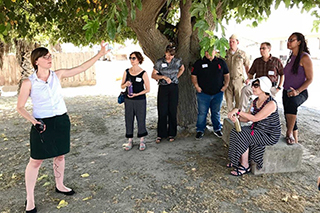May 02, 2019
A new documentary, nearly seven minutes long, provides a firsthand look at a tour of communities affected by industrial development in and around the cities of Stockton and Fresno, in California’s San Joaquin Valley. The July 2018 tour was organized by members of the Environmental Health Sciences Center (EHSC) at the University of California, Davis. Linda Birnbaum, Ph.D., director of NIEHS and the National Toxicology Program, and other NIEHS representatives also joined the tour.

Birnbaum, seated, and others listened to a presentation by Ashley Werner, J.D., from the Leadership Counsel for Justice and Accountability in Daleville, an unincorporated community south of Fresno.
(Photo courtesy of John Schelp)
Aubrey Thompson, program manager of the EHSC Community Engagement Core (CEC), supported by Jonathan London, Ph.D., co-director of the CEC, worked with the center’s community partners to facilitate workshops and conversations during the tour. Seven community groups participated in the tour: Central California Environmental Justice Network, Central Valley Air Quality Coalition, Fathers and Families of San Joaquin, Leadership Counsel for Justice and Accountability, Central California Asthma Collaborative, Community Water Center, and Californians for Pesticide Reform, as well as residents of Daleville and Moraga in the Fresno area.
“This environmental justice tour has shown me the extent of environmental injustice that is occurring in the San Joaquin Valley,” said Birnbaum in the documentary. “Our environment is our health, and who knows their health and their environment better than the people who are impacted?”
Tour attendees learned how communities have mobilized to address environmental issues where they live. For example, in the documentary, Gustavo Aguirre, Jr., from the Central California Environmental Justice Network, describes how their group successfully advocated for a local ordinance that would require setback distances between oil and gas production sites and residential sites. Community members collected and then used data to inform a protective setback ordinance. Aguirre said, “The city council members listened to their community, and not special interests, and [we] got a huge victory.”
Watch the documentary to learn more about how communities and EHSC researchers are working together to address environmental health and justice issues.


